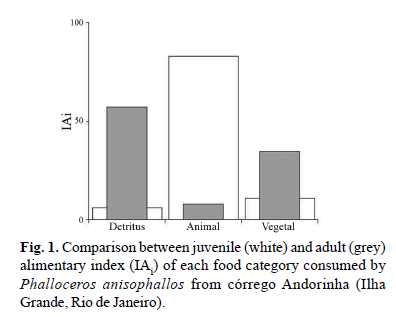In the present work, we determined the relative importance of allochthonous and autochthonous food items as well as seasonal and ontogenetic variation in the feeding habits of Phalloceros anisophallos from córrego Andorinha, Ilha Grande. Quantitative analysis, based on alimentary index (IAi) and food volume (Vo), revealed that P. anisophallos fed on detritus, autochthonous algae (diatoms, unicellular and filamentous Chlorophyceae algae), autochthonous animals (aquatic insect larvae: Trichoptera, Chironomidae and other Diptera) and allochthonous animals (terrestrial insects: Hymenoptera). Ontogenetic variations were recorded for the consumption of each food category. Adults used a larger amount of algae and detritus, and juveniles used a higher amount of animal items. Significant differences in intestinal coefficient between adult and juvenile individuals corroborated the ontogenetic differences in feeding behavior. IAi values of each consumed food category did not vary between the rainy and dry seasons, but mean detritus Vo differed between seasons and was significantly (Anova, p<0.01) greater during the dry season.
Poeciliidae; Atlantic Rain Forest; Coastal stream; Ontogeny; Seasonality


